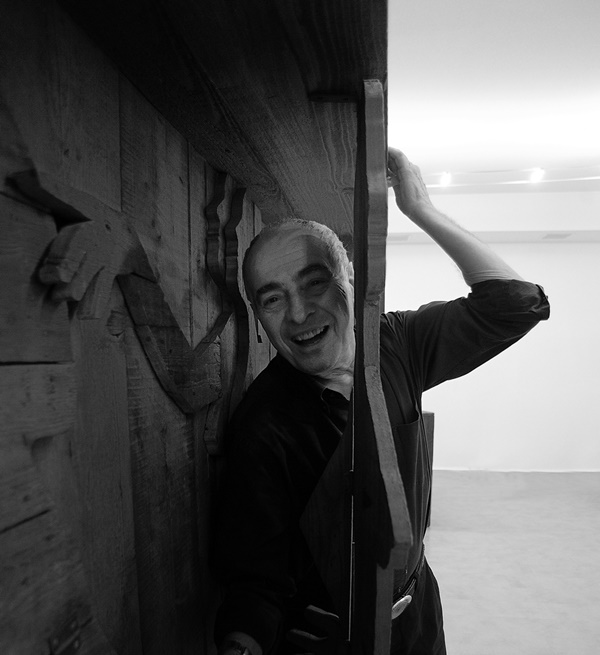"The Great Opportunity" (La grande occasione)


tel.fax: +39. 051. 221308 e-mail:This email address is being protected from spambots. You need JavaScript enabled to view it.




Mario Ceroli

Galleria de'Foscherari
Via Castiglione 2B - 40124 Bolognatel.fax: +39. 051. 221308 e-mail:


JUNE 7 > OCTOBER 7, 2018

La grande occasione (“The Great Opportunity”) is the title, suggested by the artist himself, of the solo exhibition that Mario Ceroli will be opening at Galleria de’ Foscherari on Thursday, June 7 at 6 pm.
It is a great opportunity for this artist, who—having just turned eighty—is “rereading” (his term) a lifetime made vibrant by the extraordinary work he has done up to now; a great opportunity for the gallery, which—fifty years after the artist’s first solo show, his famous Aria di Daria—is exhibiting some of his most recent and significant works; a great opportunity for art lovers and critics, who can get their first glimpse of the concluding chapter (though luckily still an early draft) in the oeuvre of one of Italy’s greatest living artists.
One should note that the opening text in the catalogue for the last Ceroli exhibition presented by de’ Foscherari (in 2012, his ninth solo show at the gallery) posed the question of whether the artist should at this point be ranked among the classics, or whether his work had yet to strike a truce with the Muses, preserving a potential for innovation that could still set new experimental processes in motion. This exhibition offers an opportunity—another great one, we hope—to venture some answer to this question. Unquestionably innovative, it may seem to mark a break from his habit of replacing the world with rough pine, yet is actually connected to it by threads that while thin, are extremely strong. True enough, these works are no longer sculptures, but looking at large paintings like Erotismo pompeiano (Pompeian red is one of Ceroli’s favorite colors) or Eco di un bacio, or Io la terra e la luna, we are struck by the similarities between their parentheses and brackets and those large letters of the alphabet cut into wood. Too flimsy a connection? Then let’s move on to Onde gravitazionali or La nuova coppia or Figura di donna, which like the others are made with oil pastels applied by hand, and we will find the image of a tree trunk whose concentric circles are twisted, wrapping around each other to hint at figures. Still not enough? In Ceroli’s house in Rome, there’s a table made from the cross-section of a three-thousand-year-old sequoia; the life lines of that tree seem to have been animated and colored in by the artist, who has set them on the canvas to remind us that at the origin of his work is the tree, and its natural life.
Nor should we forget that in 1970 he made a famous piece titled L’albero della vita (“The Tree of Life”), or that the tree is not just a biblical symbol, but a fundamental reference in every culture. So here is Ceroli’s great opportunity: a chance to get to the root of his artistic practice and discover that it is also the origin of life.
It is a great opportunity for this artist, who—having just turned eighty—is “rereading” (his term) a lifetime made vibrant by the extraordinary work he has done up to now; a great opportunity for the gallery, which—fifty years after the artist’s first solo show, his famous Aria di Daria—is exhibiting some of his most recent and significant works; a great opportunity for art lovers and critics, who can get their first glimpse of the concluding chapter (though luckily still an early draft) in the oeuvre of one of Italy’s greatest living artists.
One should note that the opening text in the catalogue for the last Ceroli exhibition presented by de’ Foscherari (in 2012, his ninth solo show at the gallery) posed the question of whether the artist should at this point be ranked among the classics, or whether his work had yet to strike a truce with the Muses, preserving a potential for innovation that could still set new experimental processes in motion. This exhibition offers an opportunity—another great one, we hope—to venture some answer to this question. Unquestionably innovative, it may seem to mark a break from his habit of replacing the world with rough pine, yet is actually connected to it by threads that while thin, are extremely strong. True enough, these works are no longer sculptures, but looking at large paintings like Erotismo pompeiano (Pompeian red is one of Ceroli’s favorite colors) or Eco di un bacio, or Io la terra e la luna, we are struck by the similarities between their parentheses and brackets and those large letters of the alphabet cut into wood. Too flimsy a connection? Then let’s move on to Onde gravitazionali or La nuova coppia or Figura di donna, which like the others are made with oil pastels applied by hand, and we will find the image of a tree trunk whose concentric circles are twisted, wrapping around each other to hint at figures. Still not enough? In Ceroli’s house in Rome, there’s a table made from the cross-section of a three-thousand-year-old sequoia; the life lines of that tree seem to have been animated and colored in by the artist, who has set them on the canvas to remind us that at the origin of his work is the tree, and its natural life.
Nor should we forget that in 1970 he made a famous piece titled L’albero della vita (“The Tree of Life”), or that the tree is not just a biblical symbol, but a fundamental reference in every culture. So here is Ceroli’s great opportunity: a chance to get to the root of his artistic practice and discover that it is also the origin of life.









